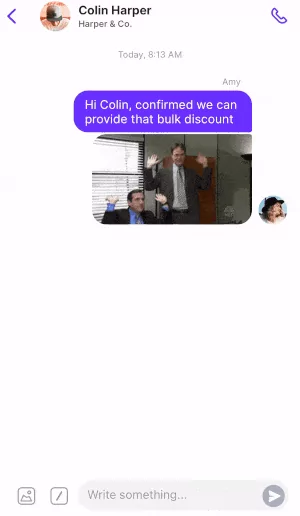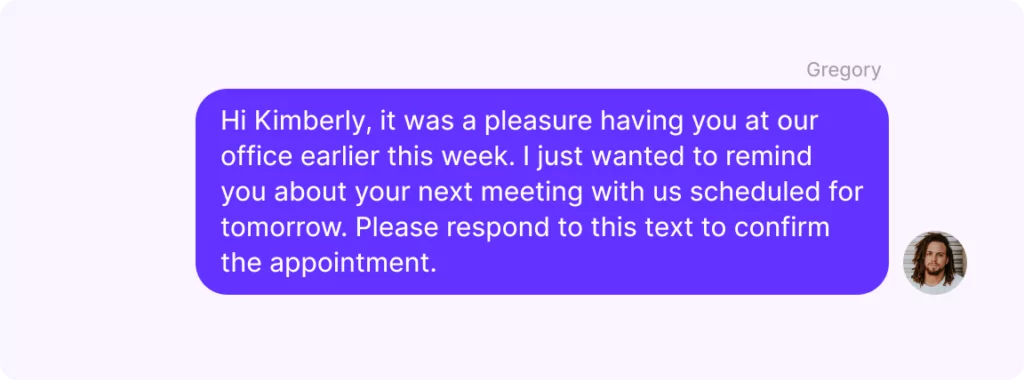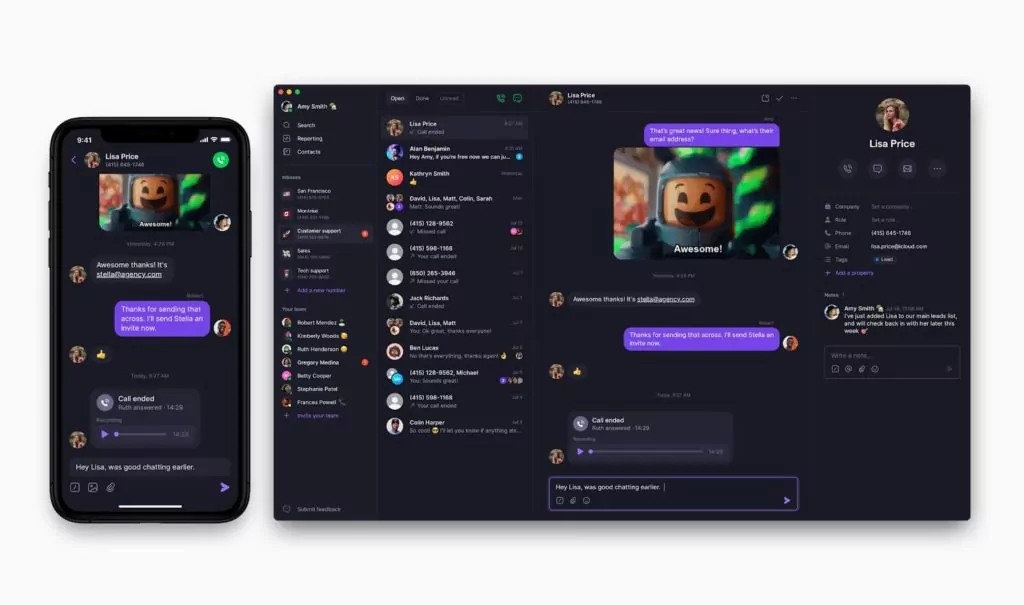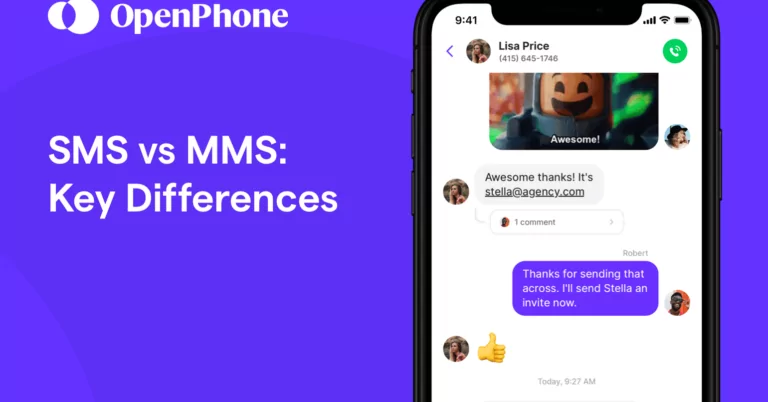Like most phones, yours likely blends SMS and MMS messages into a single, cohesive timeline, so you may not even realize that the two are different. Receiving an SMS message can feel just like getting an MMS. But when you’re using text messaging for business, knowing the differences between SMS vs MMS becomes key for great team and client communication. 📱
We’ll explain what the two acronyms really mean, then dive into the major distinctions between SMS and MMS.
SMS vs MMS
SMS, or Short Message Service, is a text messaging service that allows you to send text messages up to 160 characters in length. On the other hand, MMS, or Multimedia Messaging Service, is a type of message that can include not only text, but also multimedia content such as images, audio files, short video clips, and rich text.
Though most modern cell phones support both types of text messages, the capabilities of the two are actually quite different.
What is SMS?

SMS stands for Short Message Service. That’s exactly what it is — it’s short. SMS messages are limited to 160 characters, all in plain text. When you get an appointment confirmation text from your dentist or an “I love you” text from your mom, you’re likely getting an SMS.
SMS messaging is the simplest way to send a text. The first SMS was transmitted over cellular networks way back in 1992, which means no need for data. And since the invention of VoIP phones, you don’t even need cell service to send text messages. Simply use your internet connection, and you can easily send and receive SMS.
What is MMS?

MMS stands for Multimedia Messaging Service. Introduced a decade after SMS, MMS messaging was built to support a wide range of multimedia content and significantly longer texts. When you send a selfie or your friend responds with a GIF, you’re likely using MMS. MMS is most commonly used to send photos, but you can also send audio, videos, and other files.
With most phone carriers, MMS requires a cellular data connection. But with VoIP phones, you can send MMS with any internet connection, including WiFi.
Understanding other key differences between SMS vs MMS
To help you further understand the difference between SMS and MMS, we’ll go into further detail about the distinct qualities of each type of text. We’ll also compare SMS vs MMS in terms of deliverability and pricing.
Supported content
The biggest perk of MMS is its ability to support images, videos, GIFs, and even audio files.
While convenient, SMS messaging can be a snooze. With no ability to send rich media, SMS marketing isn’t as engaging as MMS marketing. With SMS, you’re usually limited to plain text. Any multimedia content must be sent as links.
Some carriers don’t even support emoji when using SMS. When they do, using a single emoji can reduce your total character limit to 70. Each emoji is sent as a lengthy string of characters (using a language known as Unicode) that’s translated into an icon when received.
The same goes for special characters, like Chinese and Arabic letters, so supporting international clients via SMS can be more difficult.
Character limits
SMS messages are limited to 160 characters, which, as noted, might be fewer if including special characters or emojis. MMS character limits can vary between carriers, but modern VoIP phones (like OpenPhone) can support up to 1,600 characters per text.
You can still type over 160 characters with SMS. However, a 164-character text will be broken up into one 153-character text and then chained together to a 9-character text. There’s a chance that those texts will arrive out of order. If you’re guiding clients or team members through a step-by-step process, your instructions may start feeling like a confusing Ikea manual.
Deliverability
The redeeming quality of SMS messaging is its reliability. Pretty much every cell phone used today supports SMS — and the best VoIP systems all do, too — which can boost the delivery rate of your business texts.
While Androids and iPhones support MMS, not every cell phone does. Sending an MMS to a phone number that can’t receive MMS messages can lead to deliverability issues. Though most US adults own smartphones, 15% still don’t. It’s harder to guarantee that your mobile marketing will go through to subscribers when using MMS.
However, if you’re sending group texts, MMS offers a better delivery experience when comparing SMS vs MMS. Sending group texts via MMS allows the entire group to seamlessly chat in one conversation — for example, if you’re collaborating with your team. With SMS, sending a text to multiple people at once is more like BCCing people on an email. Your message will simply be sent as individual texts to each person.
Pricing
SMS is usually cheaper than MMS. Since multimedia messages involve more data, each text will cost more. Though the difference is only a matter of cents (often 1-2 cents), this can add up if you’re using MMS for lots of text marketing campaigns or customer support.
The good news: most phone carriers offer SMS and MMS plans for US texts. With OpenPhone, you can get free SMS and MMS for both the US and Canada. Plus, you can send SMS and MMS messages from any device including your computer, phone, or tablet.
When should you use SMS or MMS?
SMS vs MMS messaging each have unique perks that can help you improve your business communication. Luckily, you don’t have to give up one for the other. To reap all the benefits of SMS and MMS, you simply need to know the right option for each of your text message use cases. We’ll explain when to use SMS vs MMS for business below.
SMS use cases
Due to its simplicity and strong deliverability, SMS is a great choice when you want to send texts like:

- Time-sensitive alerts
- Appointment reminders
- Policy change notifications
- Company updates
- Purchase confirmations
- General customer support responses
SMS gets messages across fast, which is exactly what you want for important or transactional texts (and other auto-reply texts) that don’t necessarily need to be engaging. You won’t have to worry about your texts not getting through to customers with certain mobile phones.
MMS use cases
When you need to send group texts or lengthy messages, MMS is the clear winner. MMS is also a great option for any conversations that can benefit from visual contexts, like:
- Messaging customers product video walkthroughs
- Troubleshooting support issues by requesting screenshots
- Sending a potential customer a job quote broken down by line items
- Providing a photo of an alternate item if a customer orders something out of stock
But compared to SMS, MMS is also powerful when used for marketing campaigns. Multimedia content can help you grab customers’ attention fast when you send:
- New product or service announcements
- Coupons or discounts
- Sales promotions
MMS is also great for humanizing your brand. Even if visuals aren’t needed, sending funny memes or video birthday messages at the right times can help you stand out and build stronger client relationships.
Don’t choose between SMS vs MMS: Access the best of both worlds

When we’re texting, it’s easy to switch between SMS and MMS without a second thought. But when you directly compare SMS vs MMS, you’ll notice that each carries its own perks. SMS, which primarily supports plain text, is simple, reliable, and cheap. MMS lets you include multimedia, letting you send highly engaging messages with fewer limitations.
Using both types of texts at the right times can help your team members communicate with clients and each other better than ever.
With a VoIP service, you can start sending SMS and MMS messages without needing to use your personal cell number. All you need is an internet connection to get started. And with OpenPhone, free SMS and MMS in the US and Canada comes standard with every plan, so you don’t have to worry about overspending on MMS.
Sign up for a free trial of OpenPhone, and you can even test out our text message automation capabilities to streamline your marketing campaigns!
